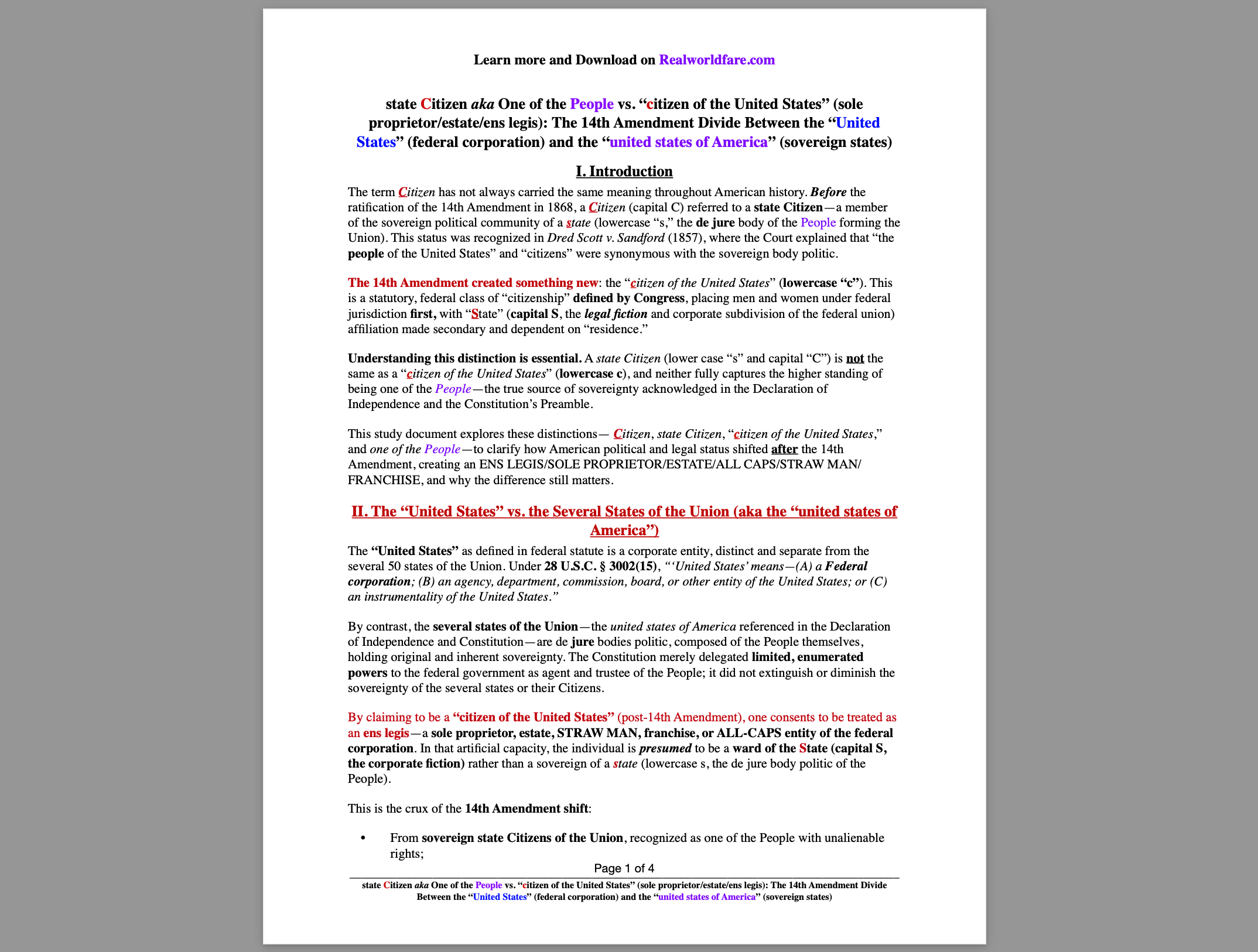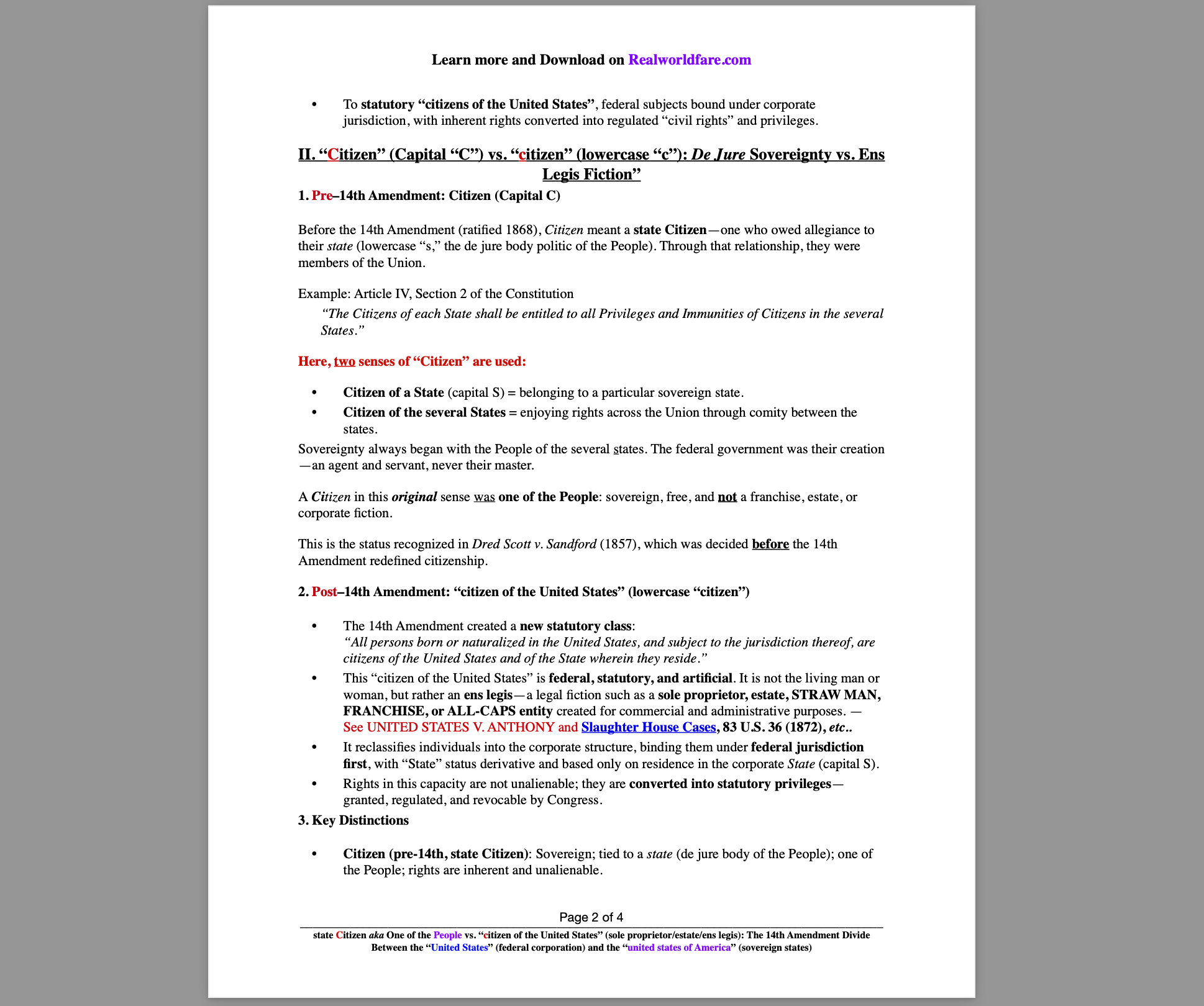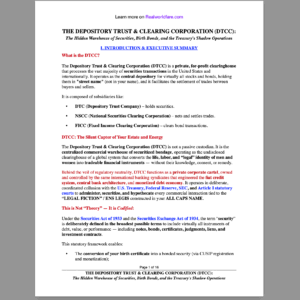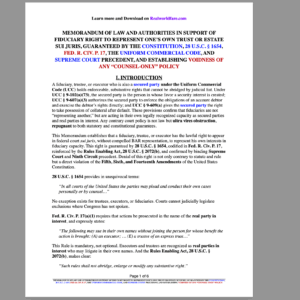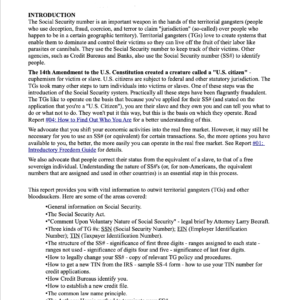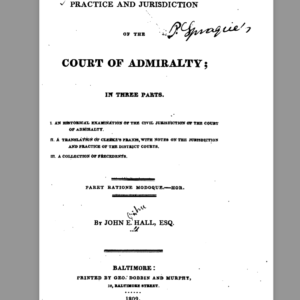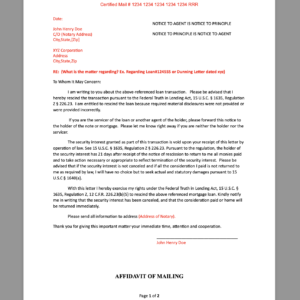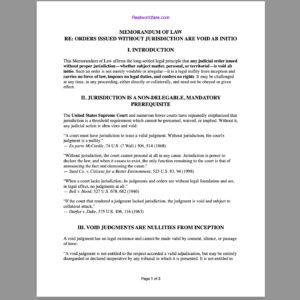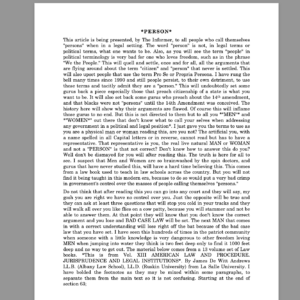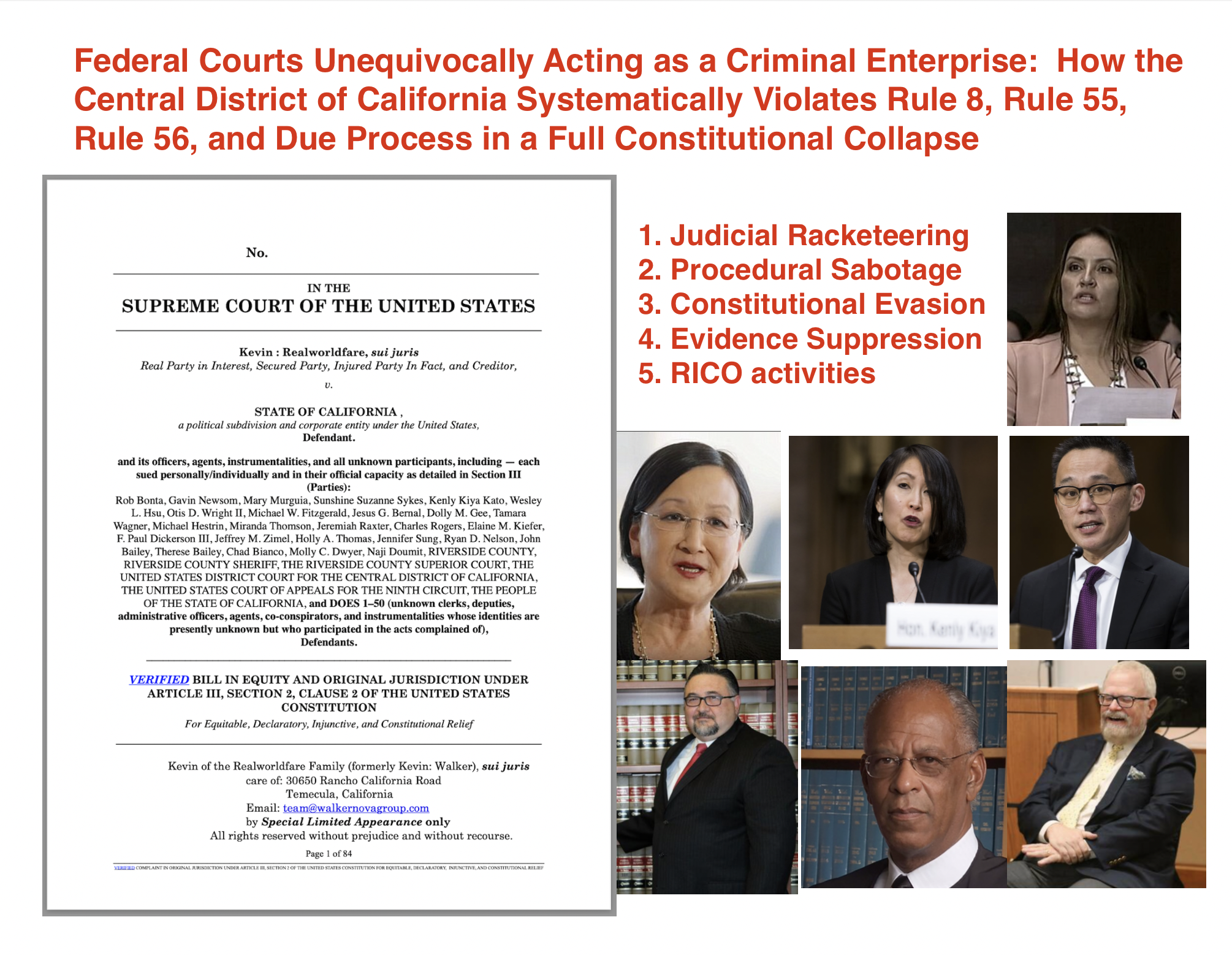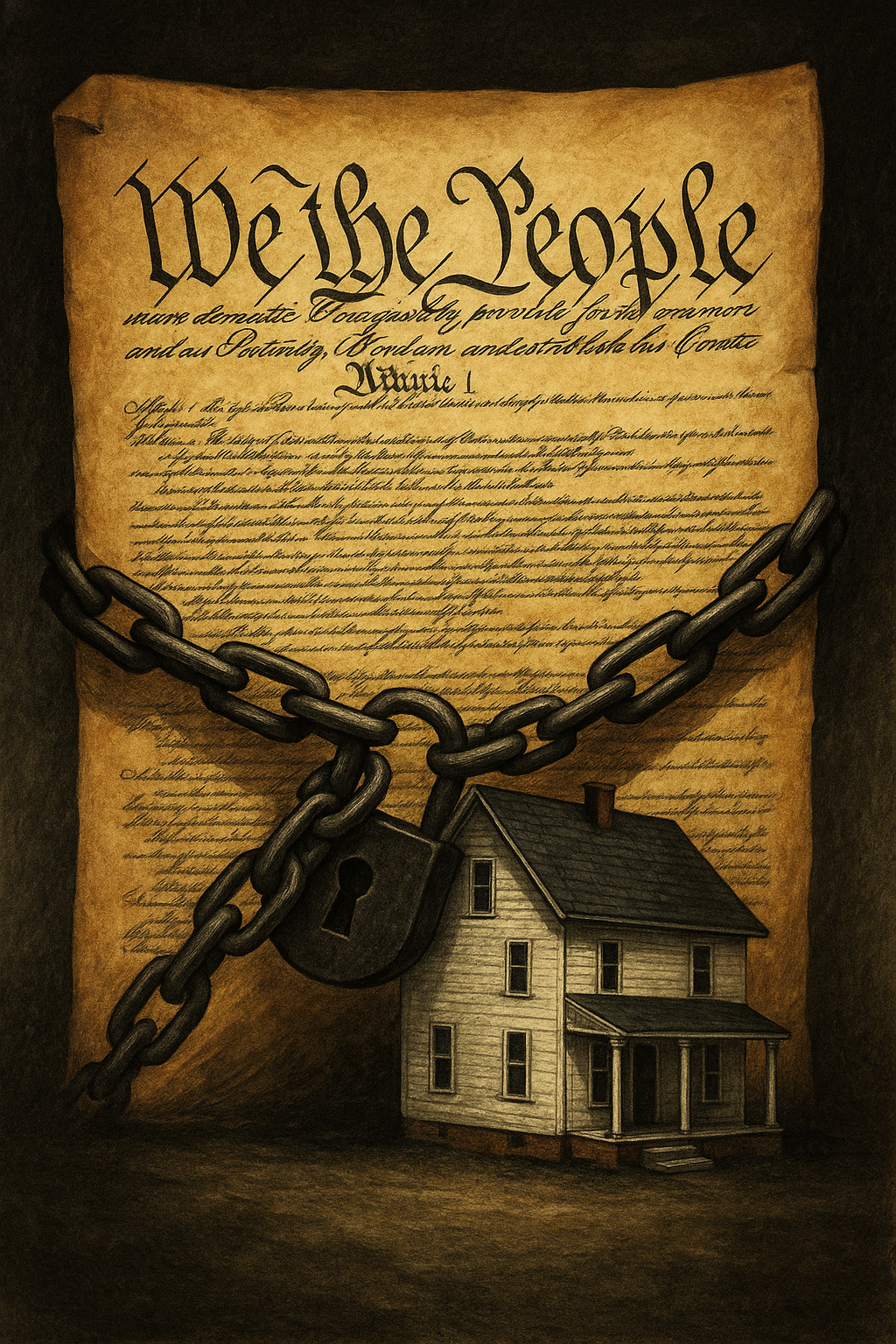I. Introduction
The term Citizen has not always carried the same meaning throughout American history. Before the ratification of the 14th Amendment in 1868, a Citizen (capital C) referred to a state Citizen—a member of the sovereign political community of a state (lowercase “s,” the de jure body of the People forming the Union). This status was recognized in Dred Scott v. Sandford (1857), where the Court explained that “the people of the United States” and “citizens” were synonymous with the sovereign body politic.
The 14th Amendment created something new: the “citizen of the United States” (lowercase “c”). This is a statutory, federal class of “citizenship” defined by Congress, placing men and women under federal jurisdiction first, with “State” (capital S, the legal fiction and corporate subdivision of the federal union) affiliation made secondary and dependent on “residence.”
Understanding this distinction is essential. A state Citizen (lower case “s” and capital “C”) is not the same as a “citizen of the United States” (lowercase c), and neither fully captures the higher standing of being one of the People—the true source of sovereignty acknowledged in the Declaration of Independence and the Constitution’s Preamble.
This study document explores these distinctions— Citizen, state Citizen, “citizen of the United States,” and one of the People—to clarify how American political and legal status shifted after the 14th Amendment, creating an ens legis/sole proprietor/estate/ALL CAPS/STRAW MAN/FRANCHISE, and why the difference still matters.
II. The “United States” vs. the Several States of the Union (aka the “united states of America”)
The “United States” as defined in federal statute is a corporate entity, distinct and separate from the several 50 states of the Union. Under 28 U.S.C. § 3002(15), “‘United States’ means—(A) a Federal corporation; (B) an agency, department, commission, board, or other entity of the United States; or (C) an instrumentality of the United States.”
By contrast, the several states of the Union—the united states of America referenced in the Declaration of Independence and Constitution—are de jure bodies politic, composed of the People themselves, holding original and inherent sovereignty. The Constitution merely delegated limited, enumerated powers to the federal government as agent and trustee of the People; it did not extinguish or diminish the sovereignty of the several states or their Citizens.
By claiming to be a “citizen of the United States” (post-14th Amendment), one consents to be treated as an ens legis—a sole proprietor, estate, STRAW MAN, franchise, or ALL-CAPS entity of the federal corporation. In that artificial capacity, the individual is presumed to be a ward of the State (capital S, the corporate fiction) rather than a sovereign of a state (lowercase s, the de jure body politic of the People).
This is the crux of the 14th Amendment shift:
- From sovereign state Citizens of the Union, recognized as one of the People with unalienable rights;
- To statutory “citizens of the United States”, federal subjects bound under corporate jurisdiction, with inherent rights converted into regulated “civil rights” and privileges.
II. “Citizen” (Capital “C”) vs. “citizen” (lowercase “c”): De Jure Sovereignty vs. Ens Legis Fiction”
1. Pre–14th Amendment: Citizen (Capital C)
Before the 14th Amendment (ratified 1868), Citizen meant a state Citizen—one who owed allegiance to their state (lowercase “s,” the de jure body politic of the People). Through that relationship, they were members of the Union.
Example: Article IV, Section 2 of the Constitution
“The Citizens of each State shall be entitled to all Privileges and Immunities of Citizens in the several States.”
Here, two senses of “Citizen” are used:
- Citizen of a State (capital S) = belonging to a particular sovereign state.
- Citizen of the several States = enjoying rights across the Union through comity between the states.
Sovereignty always began with the People of the several states. The federal government was their creation—an agent and servant, never their master.
A Citizen in this original sense was one of the People: sovereign, free, and not a franchise, estate, or corporate fiction.
This is the status recognized in Dred Scott v. Sandford (1857), which was decided before the 14th Amendment redefined citizenship.
2. Post–14th Amendment: “citizen of the United States” (lowercase “citizen”)
- The 14th Amendment created a new statutory class:
“All persons born or naturalized in the United States, and subject to the jurisdiction thereof, are citizens of the United States and of the State wherein they reside.” - This “citizen of the United States” is federal, statutory, and artificial. It is not the living man or woman, but rather an ens legis—a legal fiction such as a sole proprietor, estate, STRAW MAN, FRANCHISE, or ALL-CAPS entity created for commercial and administrative purposes. — See UNITED STATES V. ANTHONY and Slaughter House Cases, 83 U.S. 36 (1872), etc..
- It reclassifies individuals into the corporate structure, binding them under federal jurisdiction first, with “State” status derivative and based only on residence in the corporate State (capital S).
- Rights in this capacity are not unalienable; they are converted into statutory privileges—granted, regulated, and revocable by Congress.
3. Key Distinctions
- Citizen (pre-14th, state Citizen): Sovereign; tied to a state (de jure body of the People); one of the People; rights are inherent and unalienable.
- “citizen of the United States” (post-14th): Statutory subject; an ens legis / sole proprietor / estate / STRAW MAN / ALL-CAPS FRANCHISE; bound under federal jurisdiction and corporate State fiction; rights reduced to statutory privileges.
- state Citizen (capital C, lowercase s): Still distinct from “citizen of the United States”; rights remain inherent, unalienable, and secured by the Constitution—they exist independently and are not granted by it.
4. One of the People
- Higher than either classification is being one of the People of the several states.
- Authority flows from the People—the true sovereigns, acknowledged in the Declaration of Independence and the Constitution’s Preamble.
- To stand as one of the People is to stand outside statutory franchises and corporate fictions (ens legis / STRAW MAN / ALL-CAPS estate), as the original source of sovereignty itself.
III. Judicial Authorities Defining and Distinguishing a “citizen of the United States” from a “state Citizen”
- Fact: “The fourteenth amendment creates and defines citizenship of the United States. It had long been contended, and had been held by many learned authorities, and had never been judicially decided to the contrary, that there was no such thing as a citizen of the United States, except as that condition arose from citizenship of some state. No mode existed, it was said, of obtaining a citizenship of the United States, except by first becoming a citizen of some state. This question is now at rest. The fourteenth amendment defines and declares who shall be citizens of the United States, to wit, “all persons born or naturalized in the United States, and subject to the jurisdiction thereof.” The latter qualification was intended to exclude the children of foreign representatives and the like. With this qualification, every person born in the United States or naturalized is declared to be a citizen of the United States and of the state wherein he resides.”— UNITED STATES V. ANTHONY. [11 Blatchf. 200; 5 Chi. Leg. News. 462, 493; 17 Int. Rev. Rec. 197; 30 Leg. Int. 266; 5 Leg. Op. 63; 20 Pittsb. Leg. J. 199.] Circuit Court, N. D. New York. June 18, 1873.
- Fact: “It is quite clear, then, that there is a citizenship of the United States** and a citizenship of a State, which are distinct from each other and which depend upon different characteristics or circumstances in the individual.”— Slaughter House Cases, 83 U.S. 36 (1872).
- Fact: “We have in our political system a Government of the United States and a government of each of the several States. Each one of these governments is distinct from the others, and each has citizens of its own who owe it allegiance, and whose rights, within its jurisdiction, it must protect. The same person may be at the same time a citizen of the United States and a Citizen of a State, but his rights of citizenship under one of these governments will be different from those he has under the other.”— Slaughter House Cases United States vs. Cruikshank, 92 U.S. 542 (1875).
- Fact: “One may be a citizen of a State and yet not a citizen of the United States.”— Thomasson v. State, 15 Ind. 449; Cory v. Carter, 48 Ind. 327 (17 Am. R. 738); McCarthy v. Froelke, 63 Ind. 507; In Re Wehlitz, 16 Wis. 443. [McDonel v. State, 90 Ind. 320, 323 (1883)] [underlines added].
- Fact: ”The first clause of the fourteenth amendment of the federal Constitution made negroes citizens of the United States**, and citizens of the state in which they reside, and thereby created two classes of citizens, one of the United States** and the other of the state.”— [4 Dec. Dig. ’06, p. 1197, sec. 11][“Citizens” (1906), emphasis added].
- Fact: “That there is a citizenship of the United States and a citizenship of a state, and the privileges and immunities of one are not the same as the other is well established by the decisions of the courts of this country.”— [Tashiro v. Jordan, 201 Cal. 236 (1927)].
- Fact: “… both before and after the Fourteenth Amendment to the federal Constitution, it has not been necessary for a person to be a citizen of the United States in order to be a citizen of his state.”— [Crosse v. Board of Supervisors of Elections] [221 A.2d 431 (1966)].
- Fact: “The privileges and immunities clause of the Fourteenth Amendment protects very few rights because it neither incorporates any of the Bill of Rights nor protects all rights of individual citizens. See Slaughter-House Cases, 83 U.S. (16 Wall.) 36, 21 L.Ed. 394 (1873). Instead, this provision protects only those rights peculiar to being a citizen of the federal government; it does not protect those rights which relate to state citizenship.” — [Jones v. Temmer, 829 F.Supp. 1226 (USDC/DCO 1993)].
IV. In Summary
- Citizen (pre-14th Amendment) = A sovereign state Citizen (lowercase “s,” the de jure body politic of the People). Standing derives directly from the People of the several states, with unalienable rights secured by the Constitution.
- “citizen of the United States” (post-14th Amendment) = A statutory creation and legal fiction (ens legis). This is tied to the State (capital S, a corporate franchise / political subdivision of the federal union). It identifies the ALL-CAPS entity, STRAW MAN, sole proprietor, or estate, bound under federal jurisdiction first, with State status secondary and based only on residence. Rights are no longer inherent but converted into statutory “privileges.”
- state Citizen ≠ “citizen of the United States.”
- state Citizen (capital C, lowercase s) = de jure, sovereign, tied to the People, inherent and unalienable rights.
- citizen of the United States = de facto, statutory, tied to the corporate State, subject to federal jurisdiction, rights converted to privileges.
- One of the People = The original, higher authority. The true sovereign body politic acknowledged in the Declaration of Independence and the Constitution’s Preamble. From the People flows all legitimate power; they stand above both state Citizens and statutory “citizens of the United States.”

